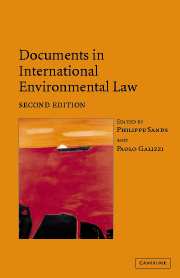Book contents
- Frontmatter
- Contents
- Preface
- PART I General instruments
- 1 Stockholm Declaration of the United Nations Conference on the Human Environment, 16 June 1972
- 2 UN General Assembly Resolution 37/7 on a World Charter for Nature, 28 October 1982
- 3 Rio Declaration on Environment and Development, 16 June 1992
- 4 Draft Articles on Prevention of Transboundary Harm from Hazardous Activities, 2001
- PART II Atmosphere
- PART III Oceans: global
- PART IIIB Oceans: regional
- PART IV Freshwater resources
- PART V Biodiversity
- PART VIA Hazardous substances and activities: nuclear
- PART VIB Hazardous substances and activities: pesticides
- PART VIC Hazardous substances and activities: waste
- PART VII Human rights and the environment
- PART VIII War and the environment
- PART IX Trade and the environment
- PART X Environmental impact assessment and access to information
- PART XI Liability for environmental damage and breaches of environmental obligations
- PART XII The Antarctic
1 - Stockholm Declaration of the United Nations Conference on the Human Environment, 16 June 1972
Published online by Cambridge University Press: 05 June 2012
- Frontmatter
- Contents
- Preface
- PART I General instruments
- 1 Stockholm Declaration of the United Nations Conference on the Human Environment, 16 June 1972
- 2 UN General Assembly Resolution 37/7 on a World Charter for Nature, 28 October 1982
- 3 Rio Declaration on Environment and Development, 16 June 1992
- 4 Draft Articles on Prevention of Transboundary Harm from Hazardous Activities, 2001
- PART II Atmosphere
- PART III Oceans: global
- PART IIIB Oceans: regional
- PART IV Freshwater resources
- PART V Biodiversity
- PART VIA Hazardous substances and activities: nuclear
- PART VIB Hazardous substances and activities: pesticides
- PART VIC Hazardous substances and activities: waste
- PART VII Human rights and the environment
- PART VIII War and the environment
- PART IX Trade and the environment
- PART X Environmental impact assessment and access to information
- PART XI Liability for environmental damage and breaches of environmental obligations
- PART XII The Antarctic
Summary
Editorial note
The UN Conference on the Human Environment was held at Stockholm from 5 to 16 June 1972. It was convened pursuant to UN General Assembly Resolution 2398 (XXIII) of 3 December 1968 (Ybk UN 1968, pp. 476–7), on a proposal from Sweden. Delegates from 113 States attended the Conference, representing most of the UN membership with the exception of the USSR, Cuba and a number of other socialist countries who refused to attend on the ground that the criteria for invitations to the Conference had effectively excluded certain States, notably the German Democratic Republic.
The Conference adopted a Declaration of Principles for the Preservation and Enhancement of the Human Environment and an Action Plan consisting of 109 Recommendations for environmental action at the international level (Report of the UN Conference on the Human Environment, UN Doc. A/CONF.48/14 at 2–65 and Corr. 1 (1972)).
The Declaration of Principles is based on a draft Declaration prepared by the Preparatory Committee for the Conference (UN Doc. A/CONF.48/PC.17). It reflects the compromise that was eventually reached between, on the one hand, those delegates who believed it should serve principally to stimulate public awareness of, and concern over, environmental issues and, on the other hand, those delegates who insisted that it should provide specific guidelines to future governmental and intergovernmental action.
In the context of transfrontier pollution the most significant of the 26 Principles are Principles 21 and 22.
- Type
- Chapter
- Information
- Documents in International Environmental Law , pp. 3 - 10Publisher: Cambridge University PressPrint publication year: 2004
- 11
- Cited by



